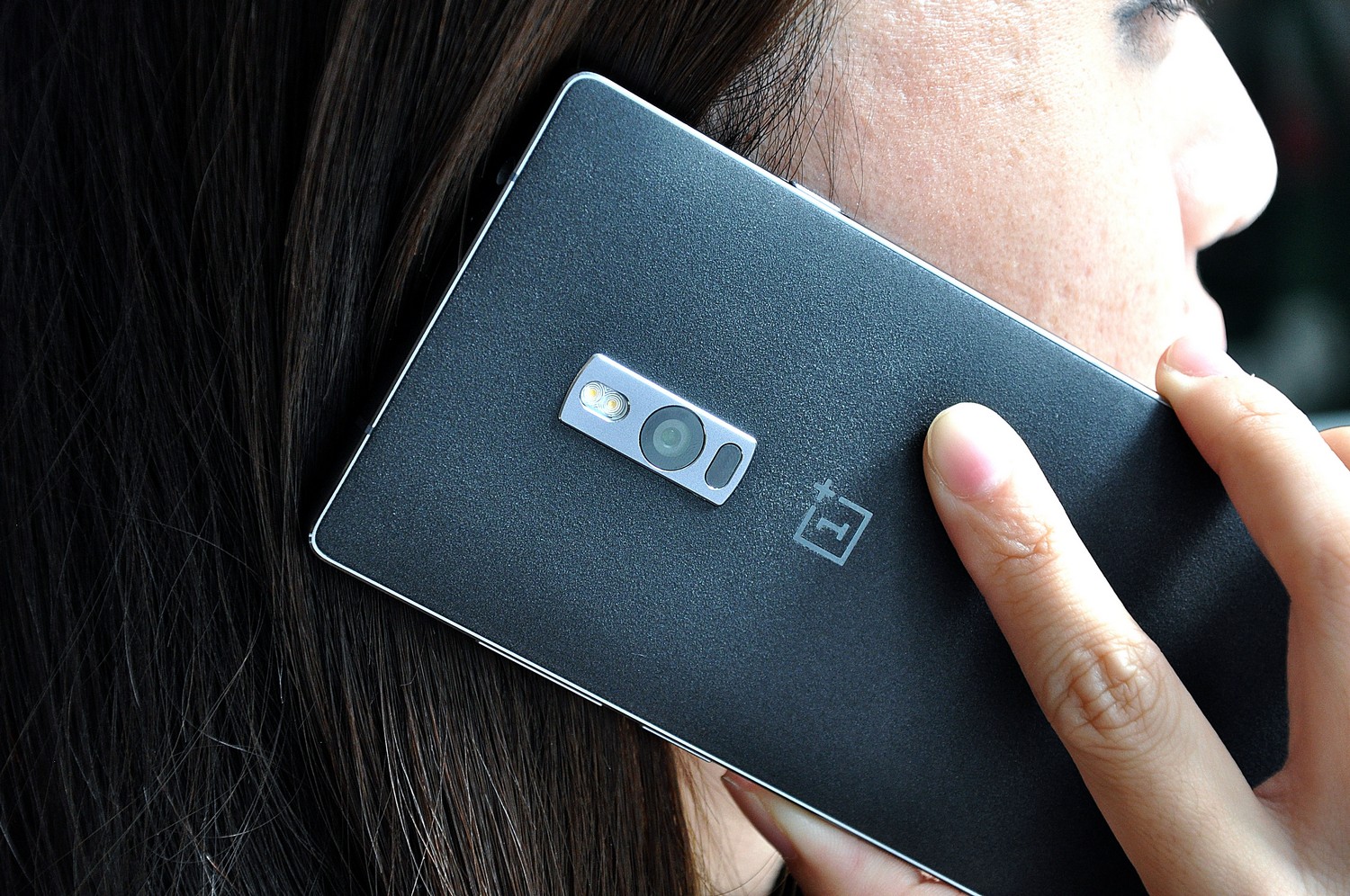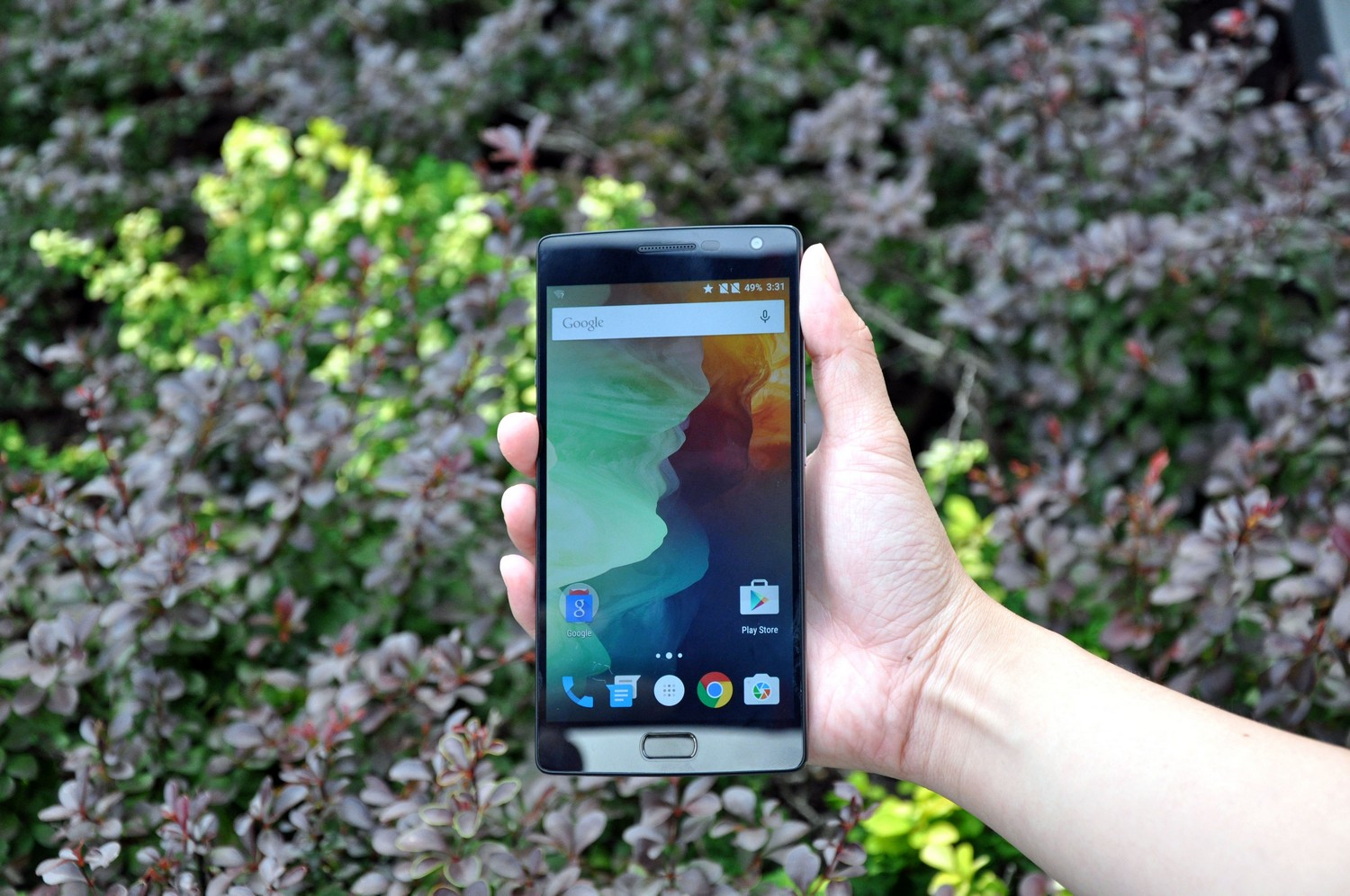Tom's Guide Verdict
Although it doesn't quite live up to the hype, the OnePlus 2 offers good performance, a unique design and a fast fingerprint sensor for an affordable price.
Pros
- +
Premium design for good price
- +
Snappy fingerprint sensor
- +
Above-average performance
- +
Nifty lock-screen gestures
- +
USB Type-C port
Cons
- -
Below-average battery life
- -
A bit heavy for screen size
- -
No NFC
- -
Dim display
Why you can trust Tom's Guide

More than 3 million people have signed up for invites to get the OnePlus 2, which could be one of the most sought-after smartphones of 2015. On paper, the supposed flagship killer looks appealing, boasting a top-notch processor, superior fingerprint sensor, large battery and intriguing new OxygenOS for just $329 (16GB; $389 as reviewed). But OnePlus' sophomore smartphone doesn’t quite live up to its lofty promises.
Design: Helpful New Touches
OnePlus kept the same look and distinctive feel as the One while adding a sturdier metal frame. Curved ever so slightly, the phone's sandstone back is covered with a gritty texture that I like for the added grip. Many of my co-workers didn't enjoy it, though. The good news is that OnePlus makes a bunch of handsome covers ($49) that look like bamboo or leather, which you can use to replace the back.

The capacitive home key looks like a physical button, but actually can't be depressed. It's slightly confusing at first. Once I realized that you just tap the button, though, I loved not having to press down hard to go home, while still being able to tell by touch where the home key was. This button also houses the fingerprint sensor.
MORE: Best Cheap Unlocked Smartphones
On the OnePlus 2's left edge is a switch that lets you toggle between having sound and alerts on, allowing just priority notifications and silencing the phone altogether. The right side has a volume rocker and power button, while a 3.5-mm headphone jack and USB Type-C port sit on the top and bottom, respectively.

At 5.9 x 2.9 x 0.39 inches, the OnePlus 2 is about the same size as other 5.5-inch phablets, such as the Alcatel Onetouch Idol 3 (6.0 x 2.9 x 0.29 inches) and the Asus ZenFone 2 (6.0 x 3.0 x 0.15-0.43 inches). It's slightly smaller than the Samsung Galaxy S6 Edge Plus (6.1 x 3.0 x 0.27 inches), which has a larger 5.7-inch screen.
Weighing 6.2 ounces, the OnePlus is heavier than the 4.9-ounce Idol 3, the 5.4-ounce Edge Plus and the 6-ounce ZenFone 2.
Fingerprint Sensor: Fast Unlocking
Not only has OnePlus installed a fingerprint sensor, it has also made it better and faster than Apple's Touch ID. I put them side by side and compared how long it took an iPhone 5s and the OnePlus 2 to unlock after I placed my finger on the sensor. The OnePlus was consistently faster. You can just lay your digit on the home key and the home screen shows up in less than a second.

So far, though, you're limited to just using the scanner to unlock your OnePlus, and nothing else. The iPhone 6's system lets you make purchases in the App Store or via Apple Pay, while the Galaxy S6 enables logging into other websites, in addition to unlocking your phone. (Samsung Pay support will be enabled in September for the Galaxy S6 and its multiple variants.)
Display: Colorful, But Not Bright Enough
The new OnePlus 2's 5.5-inch, 1920 x 1080 display was a decent canvas for a 1080p trailer for the sci-fi thriller Pod. Vivid red blood and green leaves popped against a snowy white backdrop, and claw marks on a door looked sharp. However, the screen looked somewhat dim and purple, which was more evident when I viewed it from wide angles.
On our brightness meter, the OnePlus 2's panel registered 331 nits, which is dimmer than the average smartphone (395 nits), the Galaxy S6 (490 nits) and the Idol 3 (736 nits). It's better than the ZenFone 2 (325 nits), though.

Reproducing a solid 104.4 percent of the sRGB spectrum on our colorimeter, the OnePlus 2's screen can show more hues than the Idol 3 (93.7 percent) and the ZenFone 2 (96 percent). It fell short of the smartphone average (116.2 percent) and the Galaxy S6 Edge Plus (164 percent).
OnePlus outclassed the competition in terms of color accuracy, with a Delta-E error rating of 2.0 (closer to 0 is best). That's better than the Idol 3 (2.5) and the ZenFone 2 (8.5), but in the same ballpark as the S6 Edge Plus (2.1).
The OnePlus 2's bottom-facing speaker forgot all about that bass. But not the treble. Songs like Selena Gomez's "Good For You" and Taylor Swift's "Bad Blood" lacked the low end, but had strong mid-to-high notes. This means that voices and higher-pitched instruments were louder and clearer, but the sound wasn't as full or immersive as it could have been with more bass.
OxygenOS: What’s Good, What’s Missing
I miss the customizability of Cyanogen OS on the original OnePlus One. The OnePlus 2 is powered by OxygenOS, which runs on top of Android 5.1 Lollipop. The software retains some of the cool lock-screen gestures that the original OnePlus One had, but it’s missing some features.
I like that you can draw a circle on the lock screen to trigger the camera or a V to turn on the flashlight as you could on the OnePlus One. OxygenOS also offers an App Permissions tool that Cyanogen had, which lets you set an individual app's ability to access information such as your location, messaging, media, boot-up process or device. The new interface is easier to use than Cyanogen's, as it takes fewer steps to get to each app's finer settings.
OnePlus added a Shelf page that puts your frequent contacts and recent apps a right swipe away from your home screen, but setting this up is tricky. The helpful Google Now-like feature, which is still in beta, can be enabled when you first set up your OnePlus 2 or you can do it by going into a Settings menu after you long-press the Recent Apps button.

With Cyanogen OS, you could easily change your phone's theme, wallpaper, icons, fonts, boot animation and options in the power menu, which launch when you long-press the power. OxygenOS just lets you pick your wallpaper, icon pack and whether you want to activate Dark Mode, which reverses the black-on-white theme of the phone's interface to white on black.
Also missing are the security features that were on Cyanogen OS, such as encrypted texts among CyanogenMod users, although the usefulness of that tool depends on the tech savvyness of your social circle. Cyanogen also provides a much more powerful camera app than OxygenOS does.
Performance: Better Than Average
I had no trouble switching between a YouTube video and a round of my favorite mobile game Does Not Commute with several apps in the background, thanks to the OnePlus 2's 1.8-GHz octa-core Snapdragon 810 CPU and 4GB of RAM.
Notching 3,894 on general-performance benchmark Geekbench 3, the OnePlus 2 beat the average smartphone (2,465), the octa-core Snapdragon 615-armed Idol 3 (2,029) and the quad-core Intel Atom-backed ZenFone 2 (2,832). It lost to the octa-core Samsung Exynos-powered Galaxy S6 Edge Plus, though, which scored an impressive 5,200.

On our real-world video-editing test, the OnePlus 2 converted a 204MB video from 1080p to 480p in 5 minutes and 38 seconds. That's faster than the average smartphone (6:32) and the Idol 3 (8:22), but slower than the ZenFone 2 (3:40) and the Galaxy S6 Edge Plus (4:17).
Graphics performance is where the OnePlus really shines. With an Adreno 430 graphics chip, the OnePlus 2 scored 21,507 on 3DMark Ice Storm Unlimited. That beats the smartphone average (15,033), the Idol 3 (6,384) and the ZenFone 2 (20,588), but not the Galaxy S6 Edge Plus (22,901).

Camera Performance: Good in Daylight, Struggles in Low Light
Rocking a 13-megapixel rear camera, the OnePlus 2 takes sharp, vibrant pictures in bright light. I loved how crisp the windows and lines on a distant building looked in one shot, as well as the vibrant blue sky and green leaves.

I shot the same scene with a Galaxy S6 Edge, our favorite smartphone camera at the moment, for comparison. While the contrast in the S6 Edge’s image wasn’t as great, it captured more information in the shadows.

Other than that, the OnePlus 2's camera holds its own against the reigning king of smartphone cameras. That is, until the light fades.

Indoors and in low light, the OnePlus 2 started to lose its luster. I was excited to show off a painting I had just completed, but the picture the OnePlus 2 captured was so dull and green that I didn't want to post it to Facebook.

The shot I took with the Galaxy S6 Edge was brighter and had more accurate colors overall.

My nighttime shots of the Manhattan skyline taken with the OnePlus 2 came out dark and splotchy. Buildings with black rooftops looked like loaves of burnt bread, while bright lights on Times Square buildings were blown out.

The S6 Edge was brighter overall, and had sharper, clearer details.

Like its predecessor, the OnePlus 2 can record 4K video at 30 frames per second. My clip of Manhattan streets showed vibrant yellow cabs and crisp road signs.
Up front, the 5-MP camera shot pleasant selfies that accurately reproduced my light-green dress, and individual strands of my hair were sharp.

Unlike most flagship smartphones today, however, the OnePlus 2 doesn't offer a bevy of software tools to improve your shots. Yes, there is Beauty mode to enhance your portraits, but you can only choose to toggle it on or off, instead of selecting a degree of intensity, like you can on most other phones.
Camera App: Confusing Interface, Lack of Features
While the OnePlus One's camera app offered manual controls of settings such as shutter speed and ISO light sensitivity, its successor has an almost bare interface.

First off, you have to swipe in from the left to change between stills, videos, slow-mo and panorama recording. Next to the shutter button are options to change between cameras, set a timer or see more settings. Tapping the latter brings up toggles for Beauty, HDR or Clear image modes, and only shows Beauty when the front camera is activated.

Beauty mode lightly touches up your visage, smoothing out skin imperfections. Other changes are not noticeable.

When you tap on the viewfinder to focus on a part of the scene, the gesture brings up a two-ring circle with a gear icon on top of it, but, frustratingly, pressing that symbol does nothing. We've reached out to OnePlus for an explanation, and have yet to hear back.
Battery Life: Shorter Than Average
Well, this was disappointing. Despite packing a largest-in-class 3300-mAh battery, the OnePlus 2 only managed 8 hours and 7 minutes on our battery test (Web surfing over AT&T's 4G LTE network at 150 nits).
That's longer than the ZenFone 2 (7:05), but shorter than the average smartphone (8:24), Idol 3 (9:16) and the Galaxy S6 (8:32 on T-Mobile). The OnePlus One clocked an amazing 13:16.

The included USB Type-C cable is superconvenient, since it's reversible on both ends. This means it can plug into both your OnePlus 2 and any USB port, either side up. However, the cable itself is USB 2.0, meaning it delivers slower speeds than USB 3.0 for data transfer and charging. After 15 minutes of being plugged into a power outlet, the OnePlus 2's battery indicator went from 0 percent to 20 percent, which is good, but not as good as the Samsung S6 (27 percent) and the ZenFone 2 (32 percent).

How to Get One: Still Invite Only
Just like with the OnePlus One, the company requires potential buyers to score an invite before being able to purchase a new handset. Sign up for an invite on OnePlus' web page, or get an invite from someone who has already bought a OnePlus 2. You'll have about 24 hours upon receiving your invite to buy your OnePlus 2, or it expires. After you order the phone, it should be delivered to you in no later than three weeks.
According to the company, launching a second flagship to "an exponentially larger community brings a whole set of new challenges," and the invite system helps it manage the demand. Each OnePlus 2 is assigned an invite after it's produced. In the past, OnePlus has received flak for not being able to meet demands for invitations. The company has since said it intends to ramp up production and send invites out on a rolling basis.

Bottom Line
The OnePlus 2 is like a not-quite-great Tinder date. It checks off all the right boxes on paper, but doesn’t quite do enough to make you fall head over heels. While the handset offers very good performance and an excellent fingerprint sensor for the price, it's missing the software prowess that came with Cyanogen OS. The OnePlus 2 also doesn't last as long as we'd like on a charge, and its camera could be better in low light.
If you're looking for speedy performance for less money, the Intel Atom-powered Asus ZenFone 2 breezed through various performance benchmarks and costs $299 for the 64GB version with 4GB of RAM. It also offers a solid suite of camera tools and nifty software touches. However, the OnePlus 2 has a more colorful display than the Asus, lasts longer on a charge and sports a more head-turning design. Overall, the OnePlus 2 ably takes on today's flagships by providing a premium experience at a fraction of the price, but you should temper your expectations.
Cherlynn is Deputy Editor, Reviews at Engadget and also leads the site's Google reporting. She graduated with a Master’s in Journalism from Columbia University before joining Tom's Guide and its sister site LaptopMag as a staff writer, where she covered wearables, cameras, laptops, computers and smartphones, among many other subjects.
-
lml56501 my classmate's mother-in-law makes $78 /hour on the internet . She has been unemployed for seven months but last month her check was $16983 just working on the internet for a few hours. see here now.....Reply
=======>>>>>>>>www.online-jobs9.com


